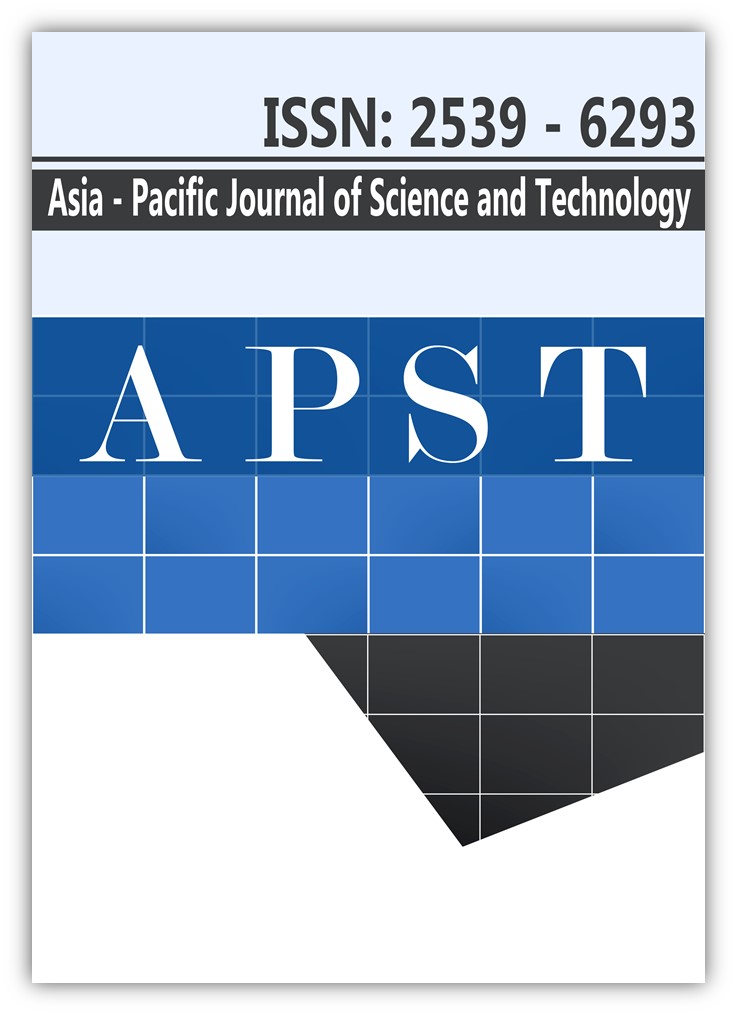Effects of type and ratio of carrier on physicochemical properties of microcapsules containing Gac fruit aril
Main Article Content
Abstract
Gac fruit aril contains high levels of carotenoids, lycopene, and β-carotene. Unfortunately, when exposed to environmental conditions, these bioactive compounds rapidly degrade. Therefore, microencapsulation must be applied in order to reduce the degradation. This study was carried out to determine the effects of the concentration of Gac aril on the efficiency of the process and on the physicochemical properties of the microcapsules. The Gac aril concentrations were varied over a range from 11.1 to 33.3% and over a range of carrier ratios from 1:3 to 1:7. The Gac aril microcapsules were analysed for efficiency and their physiochemical properties. The result indicated that using 20% Gac aril in 3% β-cyclodextrins had significantly produced a higher process yield, total carotenoid contents, encapsulation efficiency, lycopene, and β-carotene contents in the microcapsules than maltodextrin or gelatin (p < 0.05). The lowest Moisture content (MC) and Water Activity (Aw) were found at the Gac aril concentration of 25% Gac aril, which had been encapsulated with 20% maltodextrin. The optimum concentration of the carriers was 16.7 % Gac aril with maltodextrin and 20% Gac aril for both gelatin and β-cyclodextrins.
Article Details
References
[2] Vuong LT. Underutilized β-carotene-rich crops of Vietnam. Food and Nutr Bull. 2000;21(2):173-181.
[3] Chan R, Lok K, Woo J. Prostate cancer and vegetable consumption. Mol Nutr Food Res. 2009;53(2): 201-216.
[4] Guns ES, Cowell SP. Drug insight: lycopene in the prevention and treatment of prostate cancer. Nat Clin Pract Urol. 2005;2(1):38-43.
[5] Rao AV, Agarwal S. Role of lycopene as antioxidant carotenoid in the prevention of chronic diseases: a review. Nutr Res. 1999;19:305-323.
[6] Vuong LT, Dueker SR, Murphy SP. Plasma β-carotene and retinol concentrations of children increase after a 30-d supplementation with the fruit Momordica cochinchinensis (Gac). Am J Clin Nutr. 2002;75(5):872-879.
[7] Lee MT, Chen BH. Stability of lycopene during heating and illumination in a model system. Food Chem. 2002;78(4):425-32.
[8] Beatus Y, Raziel A, Rosenberg M, Kopelman IJ. Spray-drying microencapsulation of paprika oleoresin. LWT. 1985;18:28-34.
[9] Wagner L, Warthesen J. Stability of spray-dried encapsulated carrot carotenes. Food Sci. 1995;60:1048-1053.
[10] Desobry S, Nett F, Labuza T. Comparison of spray-drying, drum-drying and freeze-drying for β-carotene encapsulation and preservation. Int J Sci. 1997;62:1158-1162.
[11] Kha TC, Nguyen MH, Roach PD. Effects of spray drying conditions on the physicochemical and antioxidant properties of the Gac (Momordica cochinchinensis) fruit aril powder. Food Eng. 2010;98(3):385-392.
[12] Gharsallaoui A, Roudaut G, Chambin O, Voilley A, Saurel R.Applications of spray-drying in microencapsulation of food ingredients: an overview. Food Res Int. 2007;40:1107-1121.
[13] Özbek ZA, Ergönül PG. Influence of wall material composition on microencapsulation efficiency of cold pressed pumpkin seed oil by freeze-drying. Tech Nutr Food Sci. 2018;3:1-4.
[14] Goula AM, Adamopoulos KG. Effect of maltodextrin addition during spray drying of tomato pulp in dehumidified Air: I. drying kinetics and product recovery. Drying Technology. 2008;26(6):714-725.
[15] Bruschi M, Cardoso M, Lucchesi M, Gremiao M. Gelatin microparticles containing propolis obtained by spray-drying technique: preparation and characterization. Int J Pharm. 2003;264(1-2):45-55.
[16] Zhu X, Xu SY, Wang Z. Gelatin as microencapsulating agents for β-carotene. Food Ferment Ind. 1998;24:11-15.
[17] Youdee P, Areekul V. Microencapsulation of Gac aril using β-cyclodextrin as wall material. Proceedings 1st Joint ACS AGFD-ACS ICSCT Symposium Thailand, 2014; Mar 4-5, Bangkok: ACS; 2014.
[18] Shu B, Yu W, Zhao Y, Liu, X. Study on microencapsulation of lycopene by spray-drying. J Food Eng. 2006;76:664-669.
[19] Nguyen PM. Investigation the different ratios of carrier material to protect carotenoids in GAC (Momordica cochinchinensis spreng) powder in drying process. Int J Multidiscip Res Dev. 2014;1(2):71-76.
[20] Rocha G, Favaro-Trindade C, Ferreira Grosso C. Microencapsulation of lycopene by spray drying: Characterization, stability and application of microcapsules. Food Bioprod Process. 2012;90:37-42.
[21] AOAC International. Official methods of analysis. 17th ed. AOAC Int.: Gaithersburg, MD; 2000.
[22] Che Man YB, Irwandi J, Abdullah WJW. Effect of different types of maltodextrin and drying methods on physicochemical and sensory properties of encapsulated durian flavor. J Sci Food Agr. 1999;79:1075-1080.
[23] Nhung DTT, Bung PN, Ha NT, Phong TK. Changes in lycopene and beta carotene contents in aril and oil of Gac fruit during storage. Food Chem. 2010;121:326-331.
[24] Tran TH, Nguyen MH, Zabaras D, Vu LTT. Process development of Gac powder by using different enzymes and drying techniques. Food Eng. 2008;85:359-365.
[25] Beristain CI, Garcia HS, Vernon-Carter EJ. Spray-dried encapsulation of Cardamom (Elettaria cardamomum) essential oil with Mesquite (Prosopis juliflora) Gum. LWT. 2001;34(6):398-401.
[26] Sheu TY, Rosenberg M. Microstructure of microcapsules consisting of whey proteins and carbohydrates. Food Sci. 1998;63:491-494.
[27] Pedroza-Islas R, Vernon-Carter EJ, Dúran-Domínguez C, Trejo-Martinez S. Using biopolymer blends for shrimp feedstuff microencapsulation-I. microcapsule particle size, morphology and microstructure. Food Res. Int. 32:367-374.
[28] Shahidi F, Han X.Q. Encapsulation of food ingredients. Crit Rev Food Sci Nutr. 1993;33(6):501-547.
[29] Özkan G, Bilek SE. Microencapsulation of natural food colorants. Nutr Food Sci. 2014;3(3):145-156.
[30] Tan LH, Chan LW, Heng PWS. Effect of oil loading on microspheres produced by spray drying. J Microencapsul. 2005;22(3):253-259.


